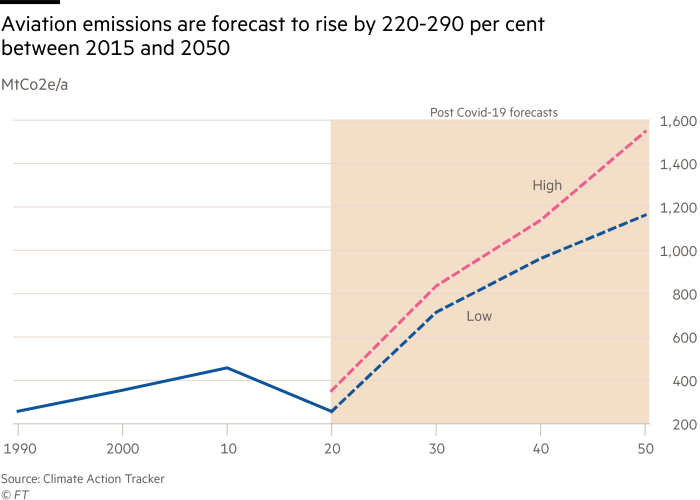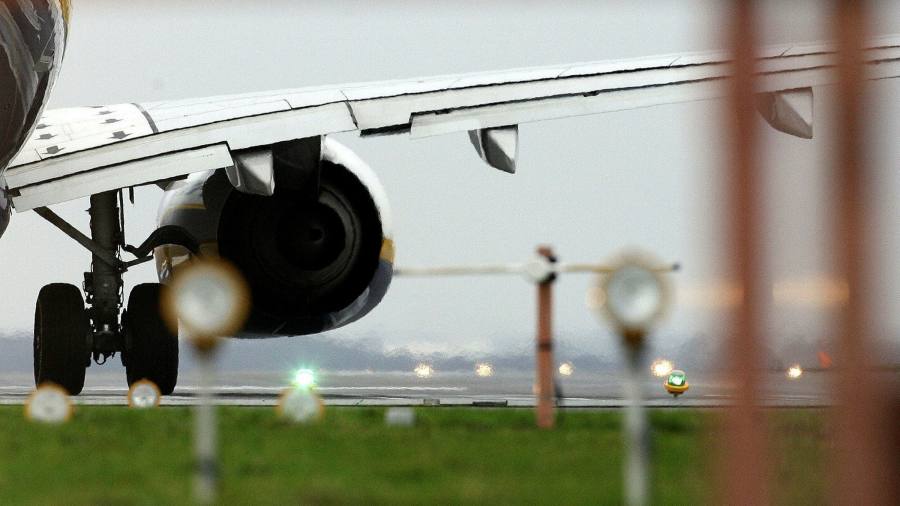[ad_1]
The aviation industry’s flagship carbon offsetting system risks being ineffective, poorly enforced and “undermining†the EU’s climate policies, according to an unpublished report written for the European Commission.
The highly critical analysis, seen by the Financial Times, was commissioned ahead of key decisions this summer on aviation in the EU’s regulated carbon market.
The report said the Carbon Offsetting and Reduction Scheme for International Aviation (Corsia) was “unlikely to materially alter the direct climate impact associated with air travel†and may offer little better than a scenario “in which international aviation emissions remain unregulatedâ€.Â
The commission is expected to propose in June how aviation industry emissions should be mitigated, including whether to include international flights in the EU Emissions Trading Scheme. The ETS limits the volume of greenhouse gases that heavy polluters can emit and requires them to buy tradeable allowances to cover their output.
The report, dated September 2020, was drawn up by several aviation and climate consultancy groups chosen by the commission, and obtained by campaign group Transport & Environment under a freedom of information request.
It said that a reliance on Corsia, rather than an expansion of the scope of the ETS, risked “weakening current EU climate policiesâ€.Â
There was no guarantee that the carbon credits purchased by airlines to offset their emissions under Corsia would be of a high quality, meaning their effect would be questionable, it concluded.
“We have wasted almost a decade coming up with an airline CO2 scheme which is actually bad for the climate,†said Jo Dardenne, aviation manager at T&E. “The study is a warning to the EU to take back responsibility for addressing pollution on European flights.â€
An industry-wide agreement to offset the growth in emissions from international aviation, Corsia is a cornerstone of the aviation’s response to rising pressure to reduce its carbon footprint. But the scheme has been criticised by environmentalists for allowing airlines to compensate for their emissions, rather than encourage reductions. Its implementation has been delayed until 2023 due to the pandemic.

Before the pandemic grounded the world’s passenger fleets, aviation accounted for about 2.4 per cent of global emissions, but it remains one of the hardest sectors to decarbonise due to the expense and other limitations of alternative fuels.
While aviation emissions per passenger have fallen 50 per cent since 1990, the surge in the number of flights drove up the industry’s carbon emissions by more than a third between 2015 and 2020.
The report considered the impact of several scenarios, including using only the ETS to regulate aviation emissions, using only Corsia, or a combination of both.Â
Expanding the ETS to cover all flights to, from and within the EU would have the biggest impact on reducing global CO2 from aviation, and cover nearly a quarter of domestic and international emissions by 2025, it found. Only flights within the European Economic Area are currently covered by the system.
Relying only on Corsia would see the largest increase in global aviation CO2 emissions, of 1.5 times by 2035 compared to 2015, even if the offsets were “assumed to be of a high qualityâ€, which was far from certain, it said.Â
“If EU participation in Corsia replaces part, or all, of its existing regulation for aviation, it is unlikely that aviation would sufficiently contribute to the 90 per cent reduction in transport emissions [target] and risks undermining the ability to reach net-zero emissions by mid-century,†it said.
The ETS is a legally binding system, it noted, while Corsia lacked a robust system for enforcing participation or compliance with its rules.Â
As well as using carbon offsets, the aviation industry plans to reduce its carbon footprint by using more efficient engines and sustainable aviation fuels, which are already in use but very expensive.
But under Corsia, airlines were likely to purchase cheaper offsets rather than switch to cleaner fuels, the report noted. New technologies such as electric or hydrogen-powered planes remain unproven, and could come into play nearer 2050.
S&P Global’s Platts CEC, which tracks the price of Corsia-eligible offsets, was valued at $2.06 per metric tonne of CO2-equivalent on Wednesday. This compares with the price of ETS allowances that hit a record high of more than $43 this week.
The report also warns about the quality of Corsia-eligible carbon offsets. None of the bodies that had been approved to certify offsets for the scheme performed all the quality control checks that the International Civil Aviation Organization said Corsia-eligible offsets had to pass, it found.Â
In some cases, Corsia’s technical advisory body had checked that certification groups had quality control systems in place — designed to ensure that offsets delivered real, additional and permanent carbon benefits — but not whether these systems were “effectiveâ€, the report said.
The International Civil Aviation Organization declined to comment, but the head of the International Air Transport Association told the FT this week that airlines were working towards tougher climate targets.
In a statement in response to the report, the European Commission said it was working on drawing up “rules to implement Corsia in a way that is consistent with the EU’s 2030 climate objectivesâ€.
Climate Capital

Where climate change meets business, markets and politics. Explore the FT’s coverage hereÂ
[ad_2]
Source link






